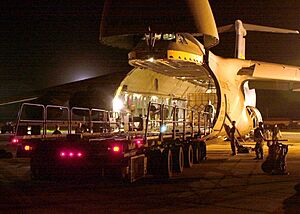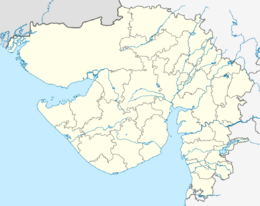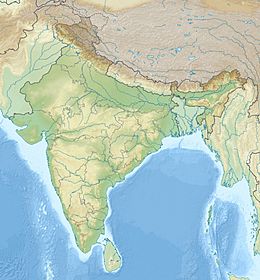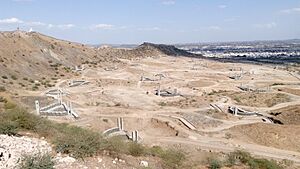2001 Gujarat earthquake facts for kids
 |
|
| UTC time | 2001-01-26 03:16:40 |
|---|---|
| ISC event | 1763683 |
| USGS-ANSS | ComCat |
| Local date | 26 January 2001 |
| Local time | 08:46 am IST |
| Duration | 90 seconds |
| Magnitude | 7.6 Mw |
| Depth | 17.4 kilometres (10.8 mi) |
| Epicenter | 23°23′17″N 70°19′34″E / 23.388°N 70.326°E |
| Type | Oblique-slip, Intraplate |
| Areas affected | India, Pakistan |
| Max. intensity | X (Extreme) |
| Casualties | 13,805–20,023 dead ~ 166,800 injured |
The 2001 Gujarat earthquake, also called the Bhuj earthquake, happened on January 26, 2001. It struck at 8:46 am local time. The earthquake's center, called the epicentre, was near the village of Chobari in the Kutch District of Gujarat, India.
This powerful earthquake measured 7.6 on the moment magnitude scale. It happened about 17.4 kilometers (10.8 miles) deep inside the Earth. The shaking was so strong that it reached an "Extreme" level on the Mercalli intensity scale. The earthquake caused a lot of damage. It killed between 13,805 and 20,023 people, including 18 in southeastern Pakistan. About 167,000 people were injured, and nearly 340,000 buildings were destroyed.
Contents
How Earthquakes Happen in Gujarat
Gujarat is about 300 to 400 kilometers (186 to 248 miles) away from where the Indian Plate and the Eurasian Plate meet. Even though it's not right on the edge, the movement of these huge plates still affects the area.
Millions of years ago, when the supercontinent Gondwana broke apart, this area had rifts, which are cracks in the Earth's crust. As the Indian Plate pushed into the Eurasian Plate, these old cracks became active again. This movement caused the ground to shorten and new thrust faults (where one block of Earth slides over another) to form. This also created hills and mountains, especially in central Kutch.
The 2001 Gujarat earthquake happened because of movement along a fault line that was not known before. This fault was hidden deep underground. It caused the ground to shift, leading to the massive shaking.
What Was the Impact?
The earthquake caused widespread destruction across Gujarat.
| Area | Deaths | Injuries |
|---|---|---|
| Bhuj | 13,572 | 21,456 |
| Ahmedabad | 729 | 827 |
| Rajkot | 385 | 1,447 |
| Jamnagar | 117 | 2,148 |
| Surendranagar | 103 | 2,673 |
| Surat | 46 | 157 |
| Banaskantha | 36 | 119 |
| Patan | 33 | 946 |
The city of Bhuj, which was only 20 kilometers (12 miles) from the earthquake's center, was hit the hardest. Many villages in Bhachau and Anjar were completely flattened. More than a million buildings were damaged or destroyed. This included many old and important buildings.
In Bhuj, about 40% of homes were destroyed. Eight schools and two hospitals also collapsed. The city's historic Swaminarayan temple and old forts like Prag Mahal and Aina Mahal were partly destroyed. Experts found that about 40% of heritage buildings in Kutch and Saurashtra were either ruined or badly damaged. Only 10% were left untouched. A public hospital in Bhuj collapsed, killing about 150 patients inside.
In Ahmedabad, a large city, 80 multi-story buildings fell down. This killed 729 people there. The total damage to property was estimated to be around $7.5 billion. In Kutch, the earthquake ruined about 60% of food and water supplies. Around 258,000 houses were destroyed, which was 90% of all homes in the district. The Bhuj Civil hospital was completely destroyed.
The Indian military quickly helped. Later, the International Federation of Red Cross and Red Crescent Society also provided support. A temporary Red Cross hospital stayed in Bhuj to help people while a new hospital was being built.
Rebuilding After the Quake
Four months after the earthquake, the Gujarat government announced a plan to rebuild and help people recover. This plan focused on different ways to rebuild in cities and villages. The estimated cost for rebuilding was about US$1.77 billion.
The main goals of the plan were to fix, build, and make houses and public buildings stronger. Other goals included helping the economy get back on track, providing health support, and rebuilding communities.
Rebuilding Homes
The housing plans focused on clearing away rubble and setting up temporary shelters. They also aimed to fully rebuild damaged houses and strengthen homes that were still standing. The plan let communities lead their own recovery efforts. People affected by the earthquake could choose to move to a new place or rebuild right where they were.
In total, 929,682 houses needed repairs, and 213,685 houses needed to be rebuilt. By 2003, a large number of these homes were either repaired (94%) or rebuilt (53%).
City Planning for Bhuj
A group called the Environmental Planning Collaborative (EPC) was asked to create a new plan for the city of Bhuj. This plan focused on making wider roads. This would help emergency vehicles get around the city more easily in the future. The EPC used a method called land readjustment. They took a small part of private land to create enough public space for wider roads. The remaining land was then given back to the original owners as new plots.
Help and Support

The Government of Gujarat created four aid packages worth up to US$1 billion. These packages helped about 300,000 families. The government also announced a US$2.5 million package to help small and medium businesses recover. The World Bank and Asian Development Bank also provided large loans to help with rebuilding.
Many countries and organizations offered help.
| Country | Relief Offered |
|---|---|
| US$550,000 | |
| 20,000 tons of rice and a 12-member medical team | |
| US$920,000 | |
| US$2 million | |
| US$602,000 | |
| US$270,000 in financial aid relief supplies | |
| 150 member emergency aid mission | |
| US$2.3 million for emergency equipment | |
| US$3 million in financial aid and US$1,14 million worth of relief supplies and equipments | |
| US$250,000 | |
| US$2.5 million through UNICEF | |
| US$200,000 grant | |
| 13 tons of relief material such as blankets and food | |
| Medical and other relief supplies | |
| US$100,000 | |
| £10 million | |
| Relief supplies up to US$5 million | |
| Relief material and supplies | |
| Relief materials and financial aid |
| Organisations | Relief Given |
|---|---|
| American Red Cross of Central New Jersey | Grant program of US$10,000 with all proceeds going to the American Red Cross Indian Earthquake Relief Fund |
| CARE International | Relief Materials |
| HelpAge India | Relief materials to rural areas and Mobile Medicare Units (MMUs) |
| Oxfam | Food distribution. shelters, temporary bathing facilities, and relief materials |
| The Red Cross and Red Crescent Movement | £10 million, 350-bed hospital, water and sanitation units, telecommunications team, and a British Red Cross logistics team |
| World Health Organization | US$1.2 million |
| Technisches Hilfswerk (THW) | Rehabilitation of Water Supply & Storage for Villages nearby Bhachau. |
| Department of International Development (DFID-UK) | Financing of Relief funds for local and international NGO working on Relief works in rural Kutch. |
Memorials
Smritivan is a special park and museum built to remember the victims of the earthquake. It is located on Bhujia Hill in Bhuj, Kutch. It opened in 2022. The park covers a large area and has more than 13,805 trees, with each tree planted for a person who died. There are also 108 small water reservoirs on the hill.
The Veer Balak Smarak in Anjar is another memorial. It honors 185 school children and 20 teachers who lost their lives during the earthquake.
See also
- Earthquake zones of India
- List of earthquakes in 2001
- List of earthquakes in India






